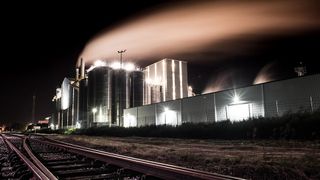Factories of the future are here
Why you should invest in smart factories

The future of manufacturing lies in the development of smart factories and environments where both machinery and equipment are digitized and connected, improving both automation and self-optimization.
The idea of overhauling your current factory systems and processes can seem like a daunting task. Still, ultimately smart factories can allow a business to operate with a level of precision otherwise impossible while simultaneously optimizing costs. By updating existing production systems, you can improve several factors, including output quality, a reduction in material and downtime costs, and optimization in labor usage. All of which has the potential to give you that all-important competitive edge needed to survive.
So how do you begin the journey from the factory to the smart factory? Ultimately, like every upgrade, it comes down to investing in software and innovation.
The use of software
When you begin thinking about transforming your factory into a smart environment, it's necessary to assess where changes need to be made. To do this, it's essential to focus on bringing people, technology and process together in one harmonious way. After all, a business stands on these three pillars, and with one out of sync, your business will miss out on achieving its full potential.
With this in mind, software should be looked at as an additional tool to streamline processes and allow your employees to focus on more important tasks. For instance, we've found that utilizing predictive analytics and cloud computing can help a factory floor better predict when to schedule necessary maintenance. This, in turn, reduces overall downtime and allows management to best schedule the distribution of their workforce each day. There really is nothing worse than a machine breaking down while you're trying to fill a big order, however, through the use of predictive analytics your machines are effectively able to speak to you and alert you when maintenance is required well ahead of a potential catastrophe. This, in turn, allows you to identify when the best time to fix an issue is as well as notify those with the expertise well in advanced tat their skills will be needed.
AI and Machine Learning can also be used to keep the cogs well-oiled as it were. In our Ricoh Telford factory, data from toner cartridges are collected through machine automation, and through Microsoft Azure, machine learning is used to predict when the machines should stop filling. Not only does this mean we can provide a consistently precise product to our customers, but it has also resulted in incredible savings, reaching up to £240k a year.
Ultimately this type of technology is just another tool in your box. It works to support your employees and processes, so you're able to deliver the best quality products your clients are after within the timeframes addressed.
Are you a pro? Subscribe to our newsletter
Sign up to the TechRadar Pro newsletter to get all the top news, opinion, features and guidance your business needs to succeed!
Tradition vs innovation
Traditionally, manufacturing has led the way in innovative practices. To meet the demand of customers and develop an edge over competitors', innovators throughout history have worked to streamline efficiencies within our factory walls. Most famous of which was Henry Ford's assembly line – whether you like him or not, his impact on the way our society makes its products still echo today.
A big part of this is because manufacturers are innovators; they design products with scientific engineering in mind, which allows them to come up with creative solutions to complex problems. Smart factories are merely the next stage of the industries natural evolution. Focusing on Azure Cloud and Machine Learning tools for a minute, I've already outlined the significant savings they provide, but they also offer incredible advancements in what you're able to provide customers. They allow you to be exact in your offerings, unlike ever before and arm your employees with the necessary tools to deliver day after day, and week after week.
A competitive edge
Being able to deliver high-quality products for your customers consistently is the key way to give yourself a competitive advantage. Utilizing technology such as AI, cloud, and machine learning ultimately tools you with the capabilities to perform better and deliver on your products and services in a timely and cost-efficient manner, therefore improving the customer experience as a whole. For instance, technology can be employed at all stages of your factory floor, from product development to intelligent production tracking. Using camera technology feeds, you can track inventory at all stages of its production cycle and feed this back to your customer, so they know exactly where their orders are and no longer have to play a guessing game.
Overall, using technology within your factory should not seem like a terrifying and complex overhaul. Instead, it should be viewed as a way to enhance your productivity and performance with margin gains subtly and streamline your processes so your employees can focus on what's important and use their skills to the best of their advantage.
- John Chambers, Director of IT, Communication, Workplace, Business Process & Application Services at Ricoh UK.
- We've listed the best cloud storage.
John is the Director of IT and Communication Services at Ricoh UK. He has UK responsibility for strategy and execution across Ricoh’s Specialist Sales teams to deliver across IT, Communication, Workplace, Business Process and Application Services into the corporate, public sector and SMB markets.
Most Popular


